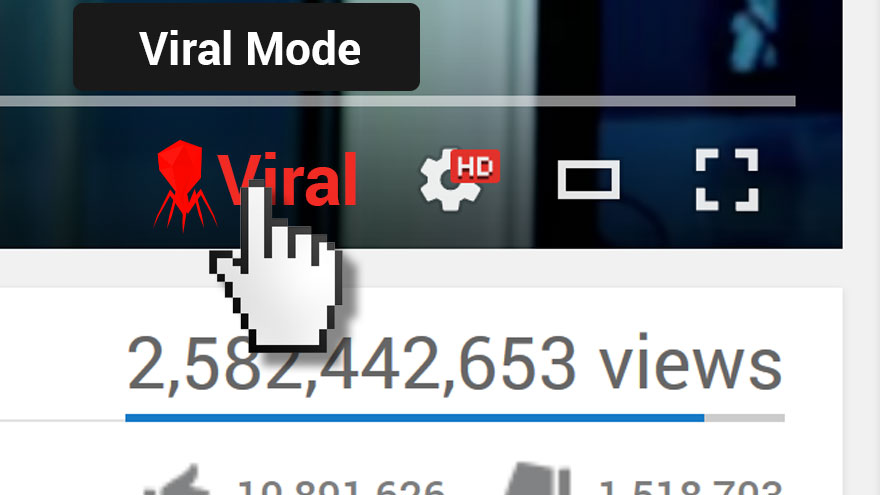“Going viral” may not be in your control – not all of us have a room full of cats, a pair of white Vans, or a kid who’s still coming down from laughing gas after the dentist to capitalize on – but it is within your reach to create a stunning, unforgettable video, and share it to the right platforms.

We all want the whole world to see our videos, but your goal should not be to make one that will go viral. Instead, aim to create something that will make your viewers want to share it. So what, exactly, will they want to share?
People share video content because they want to make others laugh, think, cry and learn. They also do it to boost their own social reach and to brand themselves as teachers, influencers and leaders.
Short, smart & sharp
Most viral videos have a few elements in common: They are snappy, funny and relatable. But, more than anything, they are remarkable. Literally. When a video makes someone remark about it on social media, most social networks’ algorithms will help others to see it, and it will begin to spread.
Get in & get out
If you want your audience to help spread your video, keep their attention spans in mind. It’s best to take up as little of their time as possible. Telling a story in under a minute can be tough, but “Charlie Bit My Finger” – clocking in at just 56 seconds – garnered almost a billion views, and “Dramatic Chipmunk” is only five seconds long (and was published six years before Vine even existed). Both videos found success because they asked very little of their audience. You click, watch for a few seconds, and hit the share button.
This Honda commercial, which aired only in the U.K., and would have been too long for American TV markets (whose commercials usually run no longer than a minute), still managed to reach American markets from shares online. It was so smart, interesting and fun to watch that its viewers did part of Honda’s distribution work for them by sharing it with their friends.
Most people aren’t going to sit through a video that runs longer than three minutes. This means they’re more likely to abandon the video before the payoff, and less likely to share it.
However, viewers in niche markets, as well as people deeper in the sales funnel or searching for long-tail keywords, will often have longer attention spans. They are looking for content that will go deeper into the subject they are interested in, so you may find that longer video makes sense in some cases.
Lights, camera, action
Amateurs can whip their iPhones out when something YouTube-worthy happens and luck into viral video success, which businesses don’t have the opportunity to do. What are the odds something is coincidentally going to happen that fits a brand’s message while they are there to catch it on camera?
Where you, as a brand, have the advantage is when it comes to production. Professional equipment leads to high-level production value, which leads to more compelling, more watchable videos. Good lighting and gear aren’t all you need either. Professional on-screen talent, voice-over actors, and animators or graphic designers are cornerstones of successful, engaging, shareable videos. In addition to tech and talent, editing can be a major part of designing a video to appeal to your audience. Good editing can squeeze in all the content, emotions, ideas, visuals and sound that make for a highly successful video.
This video for a nonprofit organization, which went viral in 2014, plays on the audience’s emotions to offer wide appeal. In under 80 seconds, there are dozens of cuts, elaborate sets and sound effects (though the video can be just as effective with the sound muted).
When you’re creating content for a brand, don’t give up on making a video in the hopes that it will rank up there with All Your Base, Damn Daniel or Star Wars Kid just because it will need to have higher production value and be less spontaneous.
When preparing to write and shoot your video, keep these three tips in mind:
- Design your video for web, especially for mobile, as YouTube visits on mobile devices have increased by 100 percent year over year. This means you’ll need to optimize for small screens, include large text, and keep the content targeted toward savvy internet users.
- Try how-to’s and vox pops. Not only can they be edited down to snappy, fast-paced, digestible pieces, but people will be more inclined to share educational, informative content that is centered around people.
- Keep length in mind. For a 90-second video, your script should usually be no longer than 200 words.
Be social
If a brand’s video goes viral, it’s entirely because the target audience is sharing it with their friends to educate, inspire or entertain. Make sharing as easy as possible by using good social media techniques. Some viewers might share directly from your video’s source, but you can get the ball rolling faster by posting your content to social media as well. This way, sharing is just one click away for your viewers.
Catch their eye
The first step in the process of encouraging your audience to spread the word about your video is getting them to find and watch it. To do this, you’ll need to use the right thumbnail. Whether you choose a frame from the video or create a custom image that matches the content, it will need to catch your audience’s eye and give them a reason to click.
Your thumbnail should be:
- Visible and legible, even on a vertical-oriented phone.
- An intriguing teaser of the climax of the video that doesn’t give too much away.
- Consistent with your brand so it is recognizable when people share it.
- Relevant to the video content. It might be tempting to choose something that is visually appealing, but otherwise irrelevant. A bait-and-switch is guaranteed to irritate your audience.
In addition to a thumbnail that pops, you’ll need to craft an equally appealing tagline, regardless of which network you choose to post the video. These should not only drive your audience to click the video, but prime them to share. In addition to featuring the appropriate tags to jump-start the sharing process, a good tagline can be:
- Indicative of the content without giving too much away.
- Lighthearted.
- A quote from the video.
- Enticing and intriguing.
- Educational.
Choose the right network
Ask yourself: “Would I want to share this myself if I was the target audience?” If so, what network would you most likely find the video on? Where would you want to share it?
There are several factors to consider in mapping your content to the right social destination, but in general, and in terms of video:
- Facebook = B2C
“People don’t want to be bombarded by brands, but when they do, they prefer lifestyle, personal and relatable content.” – Allie Stone, Social Media Executive, Brafton
- Vine = B2C
Funny, short, personal videos that tell a story in six seconds or less.
- Instagram = B2C
A top priority when using this network is to get your video to the Most Popular page, which you can do by encouraging your audience to tag their friends, since they cannot easily repost your content.
- Twitter = B2B and B2C
Twitter is a fast-paced network with a predominantly mobile user base, so shorter video content is better.
Timing matters
Ride trends, rather than get lost in them. We’re not saying that you produce a video on a trending topic – that’s usually impossible to do so quickly. Sometimes the best way to spread your video is to tie it in with what is already popular. Most social networks have listings for trending topics that can help frame your video content and carve out a designated channel of audiences that might already be interested in what you’re sharing.
Popular trends, hashtags and themes change on an hourly to monthly basis, so make sure to always keep an eye on what’s trending should an appealing topic surface. Our “12 Days of Content” video series, for example, rides the annual holiday wave, while still delivering audience-specific information.
To plan your timing for shorter-term scheduling, refer back to your social engagement analytics. They’ll give you a sense of when posting works best for your brand. Most networks give you helpful, real-time analytics of user engagement and reach patterns, and several other free and paid services can give you an even more in-depth look into your audience’s social behavior.
There’s no tried-and-true way to make a video spread across the world. Sometimes it just takes being in the right place at the right time. And as a brand, that involves producing and sharing your video with the right strategy. A combination of production value, social listening and research, and savvy posting practices will help you you strike gold. Your fans are there, eager to help your video succeed by sharing – they’re just waiting for the right video.





